Network Transport Convergence
To reduce customer churn, as well as increase subscriber penetration/satisfaction and revenues, the transport network is evolving into a highly reliable, intelligent, converged Internet protocol/Gigabit Ethernet/dense wavelength division multiplexing (IP/GigE/DWDM) network for the delivery of triple-play video, voice and data services. These network changes are allowing cable operators to reduce the time to market of new services, lower network capital costs, reduce network complexity and operational expenses, and most importantly, allow operators to effectively compete and maintain their leadership position in the broadband services market. System clustering, headend consolidation Throughout the 1990s, MSOs purchased and sold cable TV systems in an effort to consolidate their properties to achieve economies of scale, operational efficiencies, reduced cost and reduced time to market for launching new services. Various optical networking technologies have been deployed to combine closely located properties, specifically headends, into a single operating entity. In the 1990s, this was done with different types of optical transport equipment, such as synchronous optical network (SONET), asynchronous transfer mode (ATM) and uncompressed video transport systems. These were used to transport a variety of signal types to support the multiple services offered by an operator as described in Figure 1. 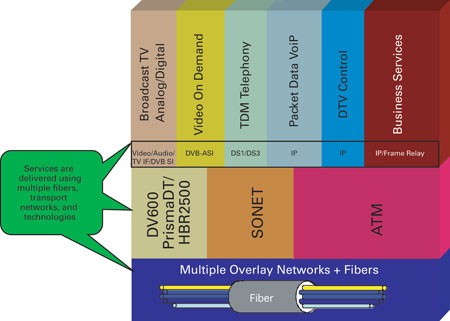 The result was metropolitan or inter-city digital transport networks consisting of several overlay networks as detailed in Figure 2.
The result was metropolitan or inter-city digital transport networks consisting of several overlay networks as detailed in Figure 2. 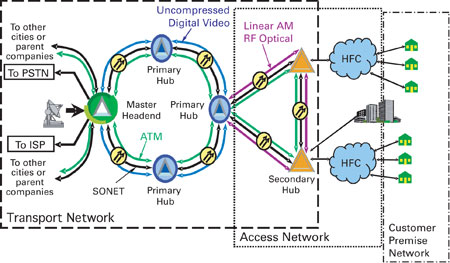 Layer 1 and DWDM Over the past five years, many cable companies have deployed unified digital optical transport networks with DWDM as the underlying and enabling layer 1 optical technology. Because of DWDM’s bit rate and protocol independent nature, cable operators have used it as a “unifying underlay” to their disparate, overlay transport networks. Consolidation of traffic from broadband cable services over unified digital DWDM optical transport networks lets operators collapse current overlays and seamlessly support newer low cost protocols, such as GigE/10 GigE and Fibre Channel, in their native formats. This is depicted in Figures 3 and 4.
Layer 1 and DWDM Over the past five years, many cable companies have deployed unified digital optical transport networks with DWDM as the underlying and enabling layer 1 optical technology. Because of DWDM’s bit rate and protocol independent nature, cable operators have used it as a “unifying underlay” to their disparate, overlay transport networks. Consolidation of traffic from broadband cable services over unified digital DWDM optical transport networks lets operators collapse current overlays and seamlessly support newer low cost protocols, such as GigE/10 GigE and Fibre Channel, in their native formats. This is depicted in Figures 3 and 4. 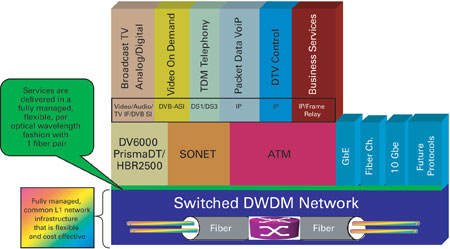
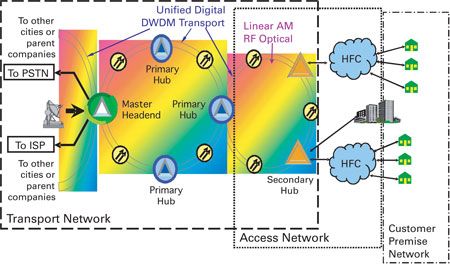 DWDM transport networks reduce fiber requirements by unlocking the embedded capacity of existing fiber infrastructures while also providing forecast tolerance for the transport network. With DWDM, cable companies have achieved operational efficiencies and savings while also positioning themselves for future revenue generating services and emerging low cost transport protocols. In addition, significant technology advancements are occurring in the areas of intelligent optical DWDM line systems and DWDM pluggable optics. These technologies include reconfigurable optical add/drop multiplexer (ROADM) line systems; intelligent data capacity and throughput management using L1/L2/L3 control mechanisms such as generalized multi-protocol label switching (GMPLS)—an example is Comcast’s recently announced Open Transport Initiative; as well as pluggable DWDM optics such as XENPAK, 10 Gigabit small form factor pluggable (XFP), small form factor pluggable (SFP) and gigabit interface connector (GBIC) that enable “transponderless” DWDM deployments. These advancements will provide increased flexibility, reduced operational complexity and lower equipment cost through the reduction of DWDM transport network components. IP/GigE/DWDM During the recent past, the cable industry has embraced IP/GigE/DWDM transport mechanisms for the delivery of high-speed data and voice over IP (VoIP) services. Significant infrastructure investments have been made in the areas of IP routing, DOCSIS and GigE/DWDM transport to support these services in a converged, reliable and affordable manner. As a result, operators must now manage traditional analog and digital video transport networks as well as the new, converged IP/GigE/DWDM digital transport network. In an effort to reduce subscriber set-top box equipment costs and provide a more competitive cable video service offering, cable companies are investigating and/or deploying new video technologies to enable the “all digital” delivery of broadcast and narrowcast video services. These will enable the industry to converge all broadcast and narrowcast video services onto the same IP/GigE transport infrastructures used for high-speed data and voice services, while also allowing the continued near term support of traditional amplitude modulation-vestigial sideband (AM-VSB) modulated analog video within the HFC access network. These technologies include DOCSIS set top gateway (DSG); digital simulcast and switching of broadcast content; IP/AM-VSB gateways; and centralized, open system, IP/GigE solid state video on demand (VOD) infrastructures providing massive real-time ingest for the everything-on-demand/network-based personal video recorder (nPVR) future. When combined, these convergence technologies result in reduced operational cost and complexity with dramatically increased service reliability. Ultimately, operators will soon have a highly scalable, converged IP/GigE/DWDM core transport network fully capable of simultaneously delivering the full suite of triple-play services. Digital simulcast, switched video Digital simulcast represents a new approach for the delivery of broadcast video content to the cable TV digital subscriber. Digital simulcast involves the duplication of all existing analog broadcast video channels in the RF quadrature amplitude modulation (QAM) digital domain. To accomplish this, existing broadcast video channels are MPEG-2 encoded in real time and/or converted to MPEG-2 single program transport streams (SPTSs) at a centralized headend location and encapsulated into IP packets with a multicast or unicast IP address. The operator’s existing IP core network is then utilized to transport the IP traffic (that is, the broadcast video channel lineup) to multiple remote hubs. If IP multicasting is employed, IP network capacity is only used once for all remote hubs and headends. At the remote headends and hubs, edge QAM devices are used to multiplex (multiple MPEG-2 SPTSs into one or more MPEG-2 multiple program transport streams, or MPTSs), modulate, encrypt and re-constitute the entire broadcast channel lineup in the 64- or 256-QAM digitally modulated signal domain. This is consistent with the traditional cable TV broadcast analog video model. By employing digital simulcast, operators eliminate the need for an AM-VSB analog tuner in the digital set-top box, resulting in reduced set-top costs, and also eliminate the “we are all digital” competitive advantage trumpeted by direct broadcast satellite (DBS) providers by offering all broadcast video channels in digital format. Operators that deploy digital simulcast have essentially duplicated existing broadcast video equipment with their IP transport networks. Originally, multiple uncompressed digital transport platforms were used to distribute the broadcast video channel suite on dedicated transport networks to remote headends and hubs. At each remote headend and/or hub, 80 or more AM-VSB modulators and/or intermediate frequency (IF) upconverters were deployed to create the analog RF channel lineup for the specific service area. The duplication of all broadcast video content in the IP domain presents another clear opportunity for the simplification of the transport network and elimination of legacy analog video gear (uncompressed video transport systems and AM-VSB modulators). A new breed of IP to AM-VSB transcoding equipment has demonstrated this. This equipment is referred to by many industry professionals as “a headend in a box.” These devices receive the same IP/GigE-based broadcast video channel lineup that is used for digital simulcast although they convert this IP traffic into multiple VSB modulated, 6 MHz, analog RF channels (for example, 44 channels in one device occupying 1 rack unit of space). Therefore, these devices enable the complete elimination of all existing uncompressed video transport equipment and AM-VSB modulators located at the remote hubs. They help complete the final piece to the IP convergence puzzle by providing the ability to reconstitute the AM-VSB analog RF channel lineup while being completely fed from a core IP transport network. Switched broadcast is a logical extension to digital simulcast. With switched broadcast, all available video channels continue to be transported in IP format in the core of the network. Only channels being viewed by at least one subscriber are broadcast in the digital spectrum of the RF plant. Studies indicate that in a given area of subscribers, not all broadcast video channels are being viewed at all points in time. Switched broadcast provides a means to exploit these patterns and achieve statistical gains in RF spectrum usage for digital broadcast. Switched broadcast continues to deal with linear broadcast video channels, although it provides a means and intelligence to only broadcast what at least one viewer is watching in a target area. Channels not currently being viewed by at least one subscriber are not broadcast, thereby saving valuable RF spectrum as well as providing a means for statistical gains in the number of channels in the broadcast channel lineup. For example, 200 or more broadcast video channels could be offered to the digital cable subscriber while only reserving enough RF bandwidth for 80. This is based on the premise that no more than 80 different channels will be viewed at any one time in a switched broadcast target area. Sound familiar? This is exactly how telephone networks have been constructed for many years. Telephone networks were constructed on the premise that not all telephones terminated by a phone switch will be in use at the same time. Hence, the public switched telephone network (PSTN) was designed to achieve statistical gains at the edges of the network (that is, more lines terminated than are available for use). This is the exact premise upon which switched broadcast will be deployed. The actual amount of statistical gain achieved by switched broadcast is arguable and is still being tested, but this a technology and approach that will be deployed by the cable industry in large quantities in 2006 to more effectively utilize available broadcast RF spectrum. Centralized VOD Early VOD server deployments were primarily based on the digital video broadcast-asynchronous serial interface (DVB-ASI) transport protocol for streaming functions with a fixed and static topology between the disk-based VOD server and associated RF edge QAM devices. The industry’s digital transport networks, dominated in the late 1990s by SONET, ATM and proprietary systems, were cost prohibitive and not well suited for the transport of native DVB-ASI. Therefore, the majority of operators enabled the early VOD service by utilizing a highly distributed architecture with VOD servers located at the majority of network hubs. To reduce content propagation and duplication, while also enabling a scalable server and storage infrastructure for the “10,000-hour library” and “80 percent unicast” future, centralized deployments of carrier class VOD server systems are now underway by many operators. This has largely been enabled by the emergence of low cost, GigE-based, DWDM optical transport systems and next generation IP/GigE based video server technology. Operators are preparing their VOD infrastructures now for the inevitable—the nonlinear, everything-on-demand viewing future. This requires massive real-time ingest capabilities as well as the separation and independent scaling of streaming/ingest and storage capacity. The DWDM transport networks, when combined with IP/GigE video servers and wire speed layer 2/layer 3 IP switches, allow for dynamic data capacity and throughput sharing/distribution across multiple server ports, blades and complexes, resulting in an inherently more reliable and scalable system than in past VOD deployments. As a result, many operators have begun deploying centralized VOD infrastructures using user datagram protocol (UDP)/IP/GigE/DWDM as the primary transport protocol for on-demand video service. (See Figure 5.)
DWDM transport networks reduce fiber requirements by unlocking the embedded capacity of existing fiber infrastructures while also providing forecast tolerance for the transport network. With DWDM, cable companies have achieved operational efficiencies and savings while also positioning themselves for future revenue generating services and emerging low cost transport protocols. In addition, significant technology advancements are occurring in the areas of intelligent optical DWDM line systems and DWDM pluggable optics. These technologies include reconfigurable optical add/drop multiplexer (ROADM) line systems; intelligent data capacity and throughput management using L1/L2/L3 control mechanisms such as generalized multi-protocol label switching (GMPLS)—an example is Comcast’s recently announced Open Transport Initiative; as well as pluggable DWDM optics such as XENPAK, 10 Gigabit small form factor pluggable (XFP), small form factor pluggable (SFP) and gigabit interface connector (GBIC) that enable “transponderless” DWDM deployments. These advancements will provide increased flexibility, reduced operational complexity and lower equipment cost through the reduction of DWDM transport network components. IP/GigE/DWDM During the recent past, the cable industry has embraced IP/GigE/DWDM transport mechanisms for the delivery of high-speed data and voice over IP (VoIP) services. Significant infrastructure investments have been made in the areas of IP routing, DOCSIS and GigE/DWDM transport to support these services in a converged, reliable and affordable manner. As a result, operators must now manage traditional analog and digital video transport networks as well as the new, converged IP/GigE/DWDM digital transport network. In an effort to reduce subscriber set-top box equipment costs and provide a more competitive cable video service offering, cable companies are investigating and/or deploying new video technologies to enable the “all digital” delivery of broadcast and narrowcast video services. These will enable the industry to converge all broadcast and narrowcast video services onto the same IP/GigE transport infrastructures used for high-speed data and voice services, while also allowing the continued near term support of traditional amplitude modulation-vestigial sideband (AM-VSB) modulated analog video within the HFC access network. These technologies include DOCSIS set top gateway (DSG); digital simulcast and switching of broadcast content; IP/AM-VSB gateways; and centralized, open system, IP/GigE solid state video on demand (VOD) infrastructures providing massive real-time ingest for the everything-on-demand/network-based personal video recorder (nPVR) future. When combined, these convergence technologies result in reduced operational cost and complexity with dramatically increased service reliability. Ultimately, operators will soon have a highly scalable, converged IP/GigE/DWDM core transport network fully capable of simultaneously delivering the full suite of triple-play services. Digital simulcast, switched video Digital simulcast represents a new approach for the delivery of broadcast video content to the cable TV digital subscriber. Digital simulcast involves the duplication of all existing analog broadcast video channels in the RF quadrature amplitude modulation (QAM) digital domain. To accomplish this, existing broadcast video channels are MPEG-2 encoded in real time and/or converted to MPEG-2 single program transport streams (SPTSs) at a centralized headend location and encapsulated into IP packets with a multicast or unicast IP address. The operator’s existing IP core network is then utilized to transport the IP traffic (that is, the broadcast video channel lineup) to multiple remote hubs. If IP multicasting is employed, IP network capacity is only used once for all remote hubs and headends. At the remote headends and hubs, edge QAM devices are used to multiplex (multiple MPEG-2 SPTSs into one or more MPEG-2 multiple program transport streams, or MPTSs), modulate, encrypt and re-constitute the entire broadcast channel lineup in the 64- or 256-QAM digitally modulated signal domain. This is consistent with the traditional cable TV broadcast analog video model. By employing digital simulcast, operators eliminate the need for an AM-VSB analog tuner in the digital set-top box, resulting in reduced set-top costs, and also eliminate the “we are all digital” competitive advantage trumpeted by direct broadcast satellite (DBS) providers by offering all broadcast video channels in digital format. Operators that deploy digital simulcast have essentially duplicated existing broadcast video equipment with their IP transport networks. Originally, multiple uncompressed digital transport platforms were used to distribute the broadcast video channel suite on dedicated transport networks to remote headends and hubs. At each remote headend and/or hub, 80 or more AM-VSB modulators and/or intermediate frequency (IF) upconverters were deployed to create the analog RF channel lineup for the specific service area. The duplication of all broadcast video content in the IP domain presents another clear opportunity for the simplification of the transport network and elimination of legacy analog video gear (uncompressed video transport systems and AM-VSB modulators). A new breed of IP to AM-VSB transcoding equipment has demonstrated this. This equipment is referred to by many industry professionals as “a headend in a box.” These devices receive the same IP/GigE-based broadcast video channel lineup that is used for digital simulcast although they convert this IP traffic into multiple VSB modulated, 6 MHz, analog RF channels (for example, 44 channels in one device occupying 1 rack unit of space). Therefore, these devices enable the complete elimination of all existing uncompressed video transport equipment and AM-VSB modulators located at the remote hubs. They help complete the final piece to the IP convergence puzzle by providing the ability to reconstitute the AM-VSB analog RF channel lineup while being completely fed from a core IP transport network. Switched broadcast is a logical extension to digital simulcast. With switched broadcast, all available video channels continue to be transported in IP format in the core of the network. Only channels being viewed by at least one subscriber are broadcast in the digital spectrum of the RF plant. Studies indicate that in a given area of subscribers, not all broadcast video channels are being viewed at all points in time. Switched broadcast provides a means to exploit these patterns and achieve statistical gains in RF spectrum usage for digital broadcast. Switched broadcast continues to deal with linear broadcast video channels, although it provides a means and intelligence to only broadcast what at least one viewer is watching in a target area. Channels not currently being viewed by at least one subscriber are not broadcast, thereby saving valuable RF spectrum as well as providing a means for statistical gains in the number of channels in the broadcast channel lineup. For example, 200 or more broadcast video channels could be offered to the digital cable subscriber while only reserving enough RF bandwidth for 80. This is based on the premise that no more than 80 different channels will be viewed at any one time in a switched broadcast target area. Sound familiar? This is exactly how telephone networks have been constructed for many years. Telephone networks were constructed on the premise that not all telephones terminated by a phone switch will be in use at the same time. Hence, the public switched telephone network (PSTN) was designed to achieve statistical gains at the edges of the network (that is, more lines terminated than are available for use). This is the exact premise upon which switched broadcast will be deployed. The actual amount of statistical gain achieved by switched broadcast is arguable and is still being tested, but this a technology and approach that will be deployed by the cable industry in large quantities in 2006 to more effectively utilize available broadcast RF spectrum. Centralized VOD Early VOD server deployments were primarily based on the digital video broadcast-asynchronous serial interface (DVB-ASI) transport protocol for streaming functions with a fixed and static topology between the disk-based VOD server and associated RF edge QAM devices. The industry’s digital transport networks, dominated in the late 1990s by SONET, ATM and proprietary systems, were cost prohibitive and not well suited for the transport of native DVB-ASI. Therefore, the majority of operators enabled the early VOD service by utilizing a highly distributed architecture with VOD servers located at the majority of network hubs. To reduce content propagation and duplication, while also enabling a scalable server and storage infrastructure for the “10,000-hour library” and “80 percent unicast” future, centralized deployments of carrier class VOD server systems are now underway by many operators. This has largely been enabled by the emergence of low cost, GigE-based, DWDM optical transport systems and next generation IP/GigE based video server technology. Operators are preparing their VOD infrastructures now for the inevitable—the nonlinear, everything-on-demand viewing future. This requires massive real-time ingest capabilities as well as the separation and independent scaling of streaming/ingest and storage capacity. The DWDM transport networks, when combined with IP/GigE video servers and wire speed layer 2/layer 3 IP switches, allow for dynamic data capacity and throughput sharing/distribution across multiple server ports, blades and complexes, resulting in an inherently more reliable and scalable system than in past VOD deployments. As a result, many operators have begun deploying centralized VOD infrastructures using user datagram protocol (UDP)/IP/GigE/DWDM as the primary transport protocol for on-demand video service. (See Figure 5.) 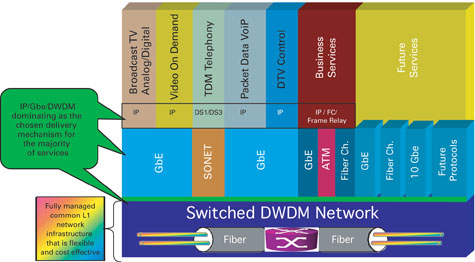 The transport network is quickly evolving into a highly reliable, intelligent, converged IP/GigE/DWDM network for the delivery of video, voice and data services. This new converged network approach allows cable operators to reduce the time to market for new services, reduce network capital costs, reduce network complexity and operational expenses, and most importantly, enable operators to effectively compete and maintain their leadership position in the highly competitive broadband services market. Christopher Skarica is VP Technical Sales, Broadbus Technologies, and Joe Selvage is VP IP Networks, Mediacom Communications. Reach them at cskarica@broadbus.com and jselvage@mediacomcc.com.
The transport network is quickly evolving into a highly reliable, intelligent, converged IP/GigE/DWDM network for the delivery of video, voice and data services. This new converged network approach allows cable operators to reduce the time to market for new services, reduce network capital costs, reduce network complexity and operational expenses, and most importantly, enable operators to effectively compete and maintain their leadership position in the highly competitive broadband services market. Christopher Skarica is VP Technical Sales, Broadbus Technologies, and Joe Selvage is VP IP Networks, Mediacom Communications. Reach them at cskarica@broadbus.com and jselvage@mediacomcc.com.